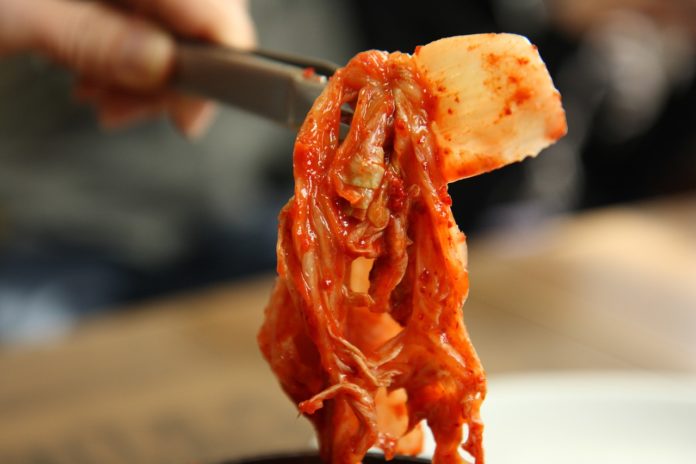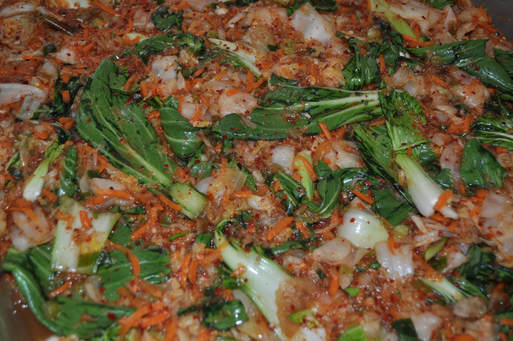
A few weeks ago, I was searching my fridge to make breakfast. I was in the mood for something Korean. I took out eggs, mushrooms, leftover rice, and kimchi. But, when I grabbed my homemade 2-year kimchi, I realized I was down to 3/4th’s of a half-gallon jar. I knew I had to act fast – having kimchi on hand is like having mustard on hand: You can never have too much, and you should always have backup.
After I finished eating my Korean fare, I took inventory of my cupboard and made a grocery list to prepare a whomping 30 pounds of fermented kimchi –eek 😛 😛 .
The downtown St. Paul Farmer’s Market wasn’t open, so I went to Hmongtown Marketplace to buy produce and to Shuang Hur for the remaining grocery items instead. Time was of the essence; I needed to get back to start soaking the cabbage in heavily salted water. However, I couldn’t find a key ingredient in my recipe. Knowing I could substitute with another ingredient, I changed my course of action and thought I’d do something different, you know, mix it up… try something new.
But before I go further, let me remind the audience that I have made kimchi for nearly 8 years -once per year- and have never failed.
Prep started out the same:
-cut the cabbage & soak in salted water
-separately, make the paste
-sanitize the jars
Meanwhile, David Bowie was playing in the background. The day was mine.

I soaked the cabbage for 12 hours, which went into the next morning. This is where things began to head south: The kitchen sink needed to be repaired, and, of course, the repairman showed up out of the blue at 8:00am to start.
-unexpectedly-
My David Bowie high from the previous day wasn’t working, now that I was facing a time crunch to drain the cabbage and finish the kimchi, all while working between a repairman. Ugh.
This is where fault #1 came into play:
Mistake #1
Do not rush kimchi or you may forget to do something very, very important. Like rinse the cabbage in cold water. Long story short, I didn’t rinse the salt off the cabbage… and I didn’t realize this until I had already mixed the cabbage with the paste.
Bummer.
What a rookie mistake. The only solution to salty cabbage was to rinse it in cold water and bulk up the kimchi and add more paste to replace what I removed. As a result, I rinsed the cabbage twice -including the paste- & went back to the market to purchase Chinese greens and ingredients to make a second round of paste.
Mistake #2
When you know what you’re doing, don’t doubt yourself.
After all the fuss of ‘fixing’ my first mistake, I made another error. Don’t let your kimchi stay out too long in a humid environment without the air conditioning running (or in a cool, dry place). When you ferment, it’s possible for mold or yeast to develop if conditions are right
-including, a warm environment, too much sugar, not enough salt-
I knew to package the kimchi after the second day, but decided against it. Even after skimming off the mold/yeast, I tried the kimchi. It tasted a bit funky, but I liked it, so I proceeded to jar it up.
After many days, it remained to be on my mind and I talked it through with my friends. Was it ok to serve? Should I throw in the towel and throw it away?
The answer, my action, toss and try again. Like many things in life, things don’t always work out the way you’d like, and that’s perfectly OK. So here I go, I’m now planning my next kimchi adventure for next week, and this time I’ll be sure to learn from my mistakes, rinse and listen.

Read next: Showdown: Soy Sauce vs. Tamari
This article by Ranelle Kirchner originally appeared on her website: ranellekirchner.com
















